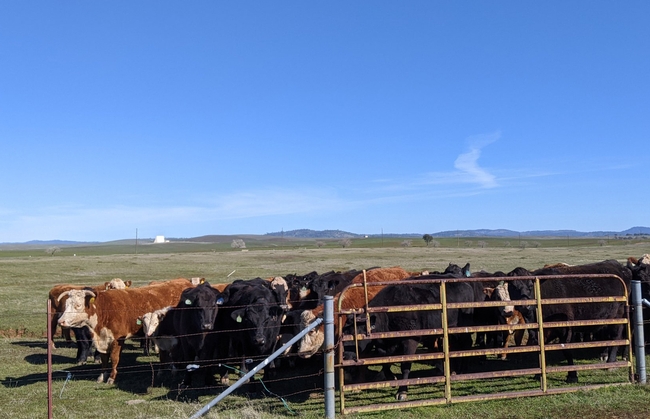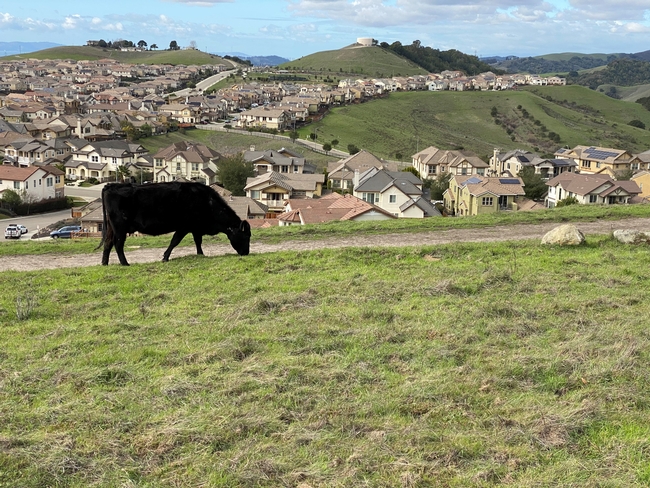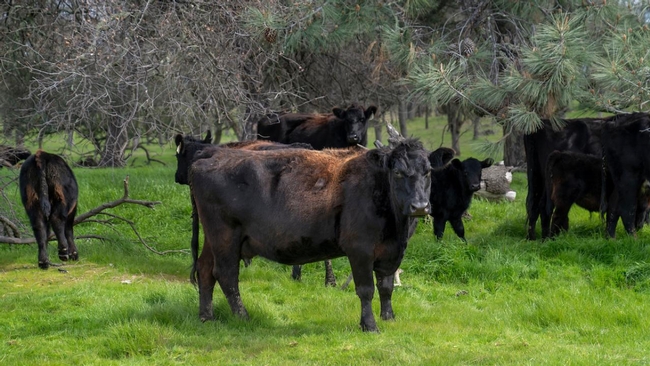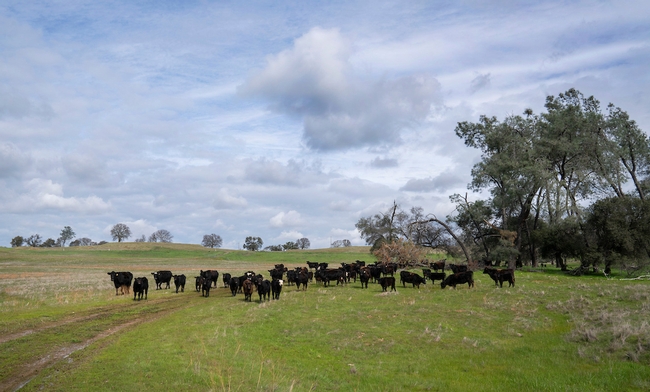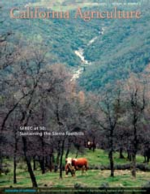Posts Tagged: Cattle
Cattle health webinars now online
University of California Cooperative Extension and UC Davis Veterinary Medicine are sharing recordings of their March 2022 cattle health webinar series for California cattle ranchers. This series was co-hosted by UC Cooperative Extension advisors Tracy Schohr, Grace Woodmansee and Rebecca Ozeran and UC Cooperative Extension specialist Gabriele Maier.
“Last month hundreds of cattle producers joined us for evening webinars that took a deep dive into a cross section of important cattle health topics,” said co-host Schohr, UC Cooperative Extension livestock and natural resources advisor in Plumas, Sierra and Butte counties.
“We recognize cattle producers have busy lives with off-ranch careers and family responsibilities that can make it difficult to attend in-person continuing education events,” she said, “so we hosted the online webinar series and have recorded them so more producers can take advantage of these comprehensive resources on cattle health and production.”
The video recordings and additional resources from the webinar series can be found at ucanr.edu/sites/Rangelands/CattleHealth. The video topics and featured speakers include:
- Whole Herd Health Plans and Vaccination Schedules - Gabriele Maier, UC Cooperative Extension specialist for beef cattle herd health and production at UC Davis, and Tom Talbot, a large animal veterinarian in Bishop
- Herd Bull Health, Diseases and Injuries - Bret McNabb, DVM, UC Davis School of Veterinary Medicine
- Pinkeye in Cattle - John Angelos, professor in UC Davis School of Veterinary Medicine
- Toxic Plants and Livestock - Robert H. Poppenga, DVM, Ph.D., DABVT, Head Toxicology Section, California Animal Health and Food Safety Laboratory, UC Davis School of Veterinary Medicine
- Why Did it Die? California Animal Health Food Safety Laboratory - Maier and Katherine Watson, anatomic pathologist at California Animal Health and Food Safety Laboratory.
“The past two years, Cooperative Extension has pivoted the way we have shared information with livestock producers with the cancellation of in-person events, allowing us to focus on new outreach tools,” said Maier. “We saw tremendous engagement with our live online Beef Quality Assurance trainings that led the team to host the series this March, focusing on topics attendees had expressed an interest in during the BQA Training. The videos provide a resource for livestock producers to continue to improve the health of their cattle and increase beef production on their ranch.”
For questions or suggestions on future topics, please contact Schohr at tkschohr@ucanr.edu.
New UC ANR publication educates public on cycles of cattle production, grazing and economics
The pandemic has brought more people into nearby parks and public lands for hiking, biking and other recreational activities. In areas like the East Bay Regional Parks – a San Francisco Bay Area park system totaling more than 120,000 acres where about 65% of the land is grazed by livestock – visitors might see goats, sheep and, most likely, cattle.
Those encounters with animals (or their manure) represent a prime opportunity for members of the public to learn about agriculture and the ecological benefits of rangelands, according to Larry Forero, a UC Cooperative Extension livestock and natural resources advisor.
As livestock grazing (mostly by beef cattle) constitutes a significant portion of land use across the state, Forero – along with fellow UCCE advisors Sheila Barry and Stephanie Larson – recently authored a UC Agriculture and Natural Resources publication summarizing the mechanics of cattle production.
“Beef Cattle on California Annual Grasslands: Production Cycle and Economics,” published in October and available as a free download on the UC ANR Catalog, describes the seasonal phases of cattle production and the factors that impact ranchers' financial calculations and management decisions.
“This concise publication walks through annual stock flows and calendar of operations and gives tables for estimating costs, return over cash, and gross income under various scenarios,” said Forero.
“Even if only a relatively small percentage of park goers are interested, you still touch a lot of people with a document like this,” Forero explained.
He said he hopes park signage and QR codes will direct visitors to the publication for more information about the cattle and their seasonal movements.
“People often wonder where the cattle go when they leave the park and when they will return,” co-author Sheila Barry said. “The cattle may go to grass or feed yards in other places in California or even out of state.”
But, as this new UC ANR publication explains, the cattle production cycle turns over anew.
“There will be more cattle next fall, I promise,” Barry said.
California’s local meat suppliers struggle to stay in business
UC Davis report suggests ways to build resilience
The University of California, Davis, Food Systems Lab has released a white paper showing the need to support California's small and mid-scale meat suppliers and processors in order to build a more resilient meat supply chain. It describes how the meat supply chain and rural economies could benefit from regulatory changes and more collaboration among producers and other stakeholders in the system.
The pandemic shut down meat processing plants in 2020, as did recent ransomware attacks on JBS, the nation's largest meat supplier. Report authors said this highlights the need to support small- and mid-scale suppliers.
“COVID and the ransomware attacks put a spotlight on how the concentration of the meat supply chain increased vulnerability in the food system,” said report co-author Tom Tomich, founder of the UC Davis Food Systems Lab and distinguished professor in the Department of Environmental Science and Policy. “We need to level the playing field so small- and mid-scale farms have an easier way to bring their product to market.”
The report says the lack of access to slaughter facilities, limited capacity of cut and wrap facilities, and concentration of marketing channels create conditions in which small- and mid-scale farms and ranches struggle to stay in business.
“These challenges are exacerbated by policies that tilt the playing field against small operators. Fortunately, new state and national legislation and programs are developing that could increase resilience in our food systems,” says Michael R. Dimock, Roots of Change program director and lead author for the report. “We need cities and counties to help fix the problems because local land use policies often impede development of resilient supply chains.”
Lack of access and limited capacity
Smaller ranchers in California have limited access to slaughter and processing facilities. In the last 50 years, California has lost half of its federally inspected meat processing plants, and the remaining facilities are unable to meet demand. Many of the 46 USDA-certified slaughter plants operating in California are closed to smaller producers.
“This means that smaller ranchers must drive hundreds of miles to reach a facility or have to wait months due to limited capacity,” said Tomich.
The report said a combination of federal, state and private investments could provide a broader geographic distribution of plants of differing scales. It also suggests expanding mobile, on-farm slaughter operations for sheep, goats and hogs, similar to those for beef.
Regulatory barriers and opportunities
Complex inspection requirements and other regulatory barriers make it difficult for small- and mid-scale producers to compete with big suppliers. The report suggests California create its own meat inspection program equivalent to the federal program to serve smaller ranchers. Prioritizing public procurement of local, high-value meat would also help expand market access for smaller producers.
Broader benefits of smaller operators
The report notes other beneficial roles of small- and mid-scale livestock operations, apart from the potential to increase resilience in our food system. Livestock grazing is a cheap and effective way to reduce wildfire risk. Supporting local meat processing also helps rural economies and creates community-based jobs.
The report was based on 27 interviews with people representing a wide spectrum of activities and points of view within the meat supply chain throughout the state. Authors are Courtney Riggle, Allan Hollander, Patrick Huber and Thomas Tomich of the UC Davis Food Systems Lab, and Michael R. Dimock with Roots of Change.
Funding for the study came from the TomKat Foundation and USDA Hatch Program.
Where's the beef?
By assigning a simple, 15-digit identification number to cows, UC researchers can track each one from conception to carcass, garnering valuable data for studies on cattle fertility, genetics, and health, and helping to select breeding animals with desirable beef characteristics such as flavor and tenderness.
In today’s beef market, an individual cow may change ownership many times during its lifetime as it travels from the ranch of its birth, to stocker and feedlot, to slaughterhouse, and finally supermarket or steakhouse. In the process, valuable data is lost along with the ability to “trace back” particular steaks to the original cow.
For several years, UC Davis researchers have been attaching a round, electronic ear tag to each newborn calf in the research herd at the UC Sierra Foothill Research and Extension Center, in the California foothills northeast of Sacramento.
The ear tags contain each cow’s unique radio-frequency-identification number, which is scanned with an electronic wand; the system is similar to that used to keep track of packages being shipped overnight or library books. Cowhands use a handheld device to enter information when the cattle are processed, which is transmitted via remote-access antennae to centrally located computer databases.
The integrated data-collection system is being used to undertake sophisticated studies on cattle genetics, with the ultimate goal of improving cattle breeding. “The genotype of some beef and dairy cattle may be better suited to grass-based productions systems,” UC Davis Cooperative Extension Specialist Alison Van Eenennaam and colleagues write in the April-June 2010 issue of California Agriculture journal. “It may also be possible to select animals that are able to grow to given size using less feed, or that are more resistant to certain diseases.
“These technologies also have great potential to enable the production of safer, more nutritious animal products. They may also allow for the selection of animals with a decreased environmental footprint and improved animal welfare due to lower levels of disease.”

Herd manager Dan Myers enters cattle
information into hand-held device.


